Integrated Nursing Practice: Assessing Pain Response in Jacob and John
VerifiedAdded on 2022/10/08
|10
|2220
|26
Report
AI Summary
This report examines the varying responses to pain in two patients, Jacob (7 years old) and John (72 years old), both suffering from tibia fractures. The discussion delves into the influence of developmental and chronological age on pain perception and management. It analyzes similarities and differences in their comprehensive assessments, focusing on identifying care needs and modifiable risk factors. The report establishes SMART goals for each case and details two home-based interventions, including medication administration and emotional support, implemented by family members. It then compares the effectiveness of these interventions through pain and edema assessments and discusses signs of intervention ineffectiveness. The conclusion highlights the importance of considering age-related differences in care provision, emphasizing the impact of physical, emotional, and perceptual maturity, as well as age-related physiological changes, on patient outcomes. The report also references multiple research papers to support the findings.
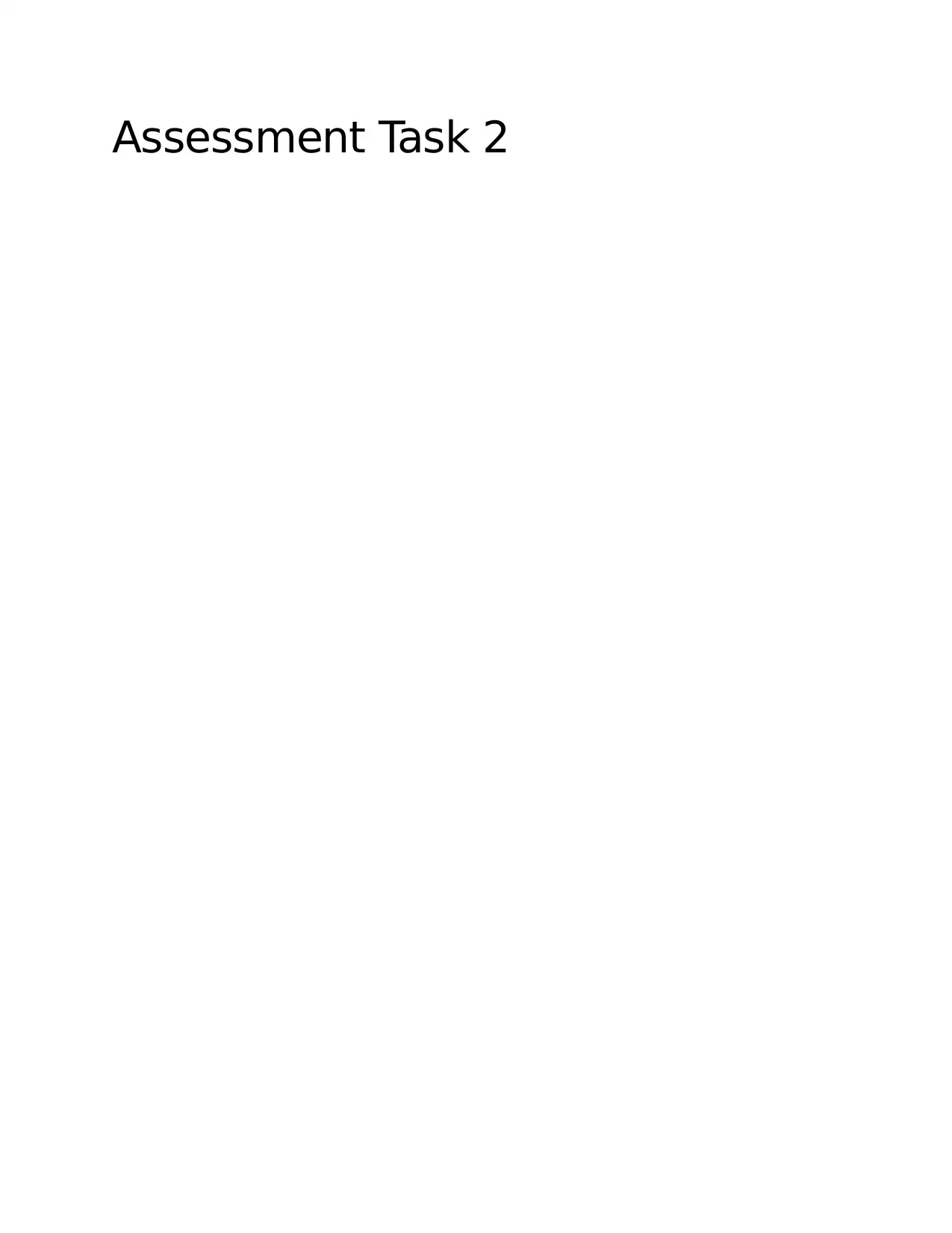
Assessment Task 2
Paraphrase This Document
Need a fresh take? Get an instant paraphrase of this document with our AI Paraphraser
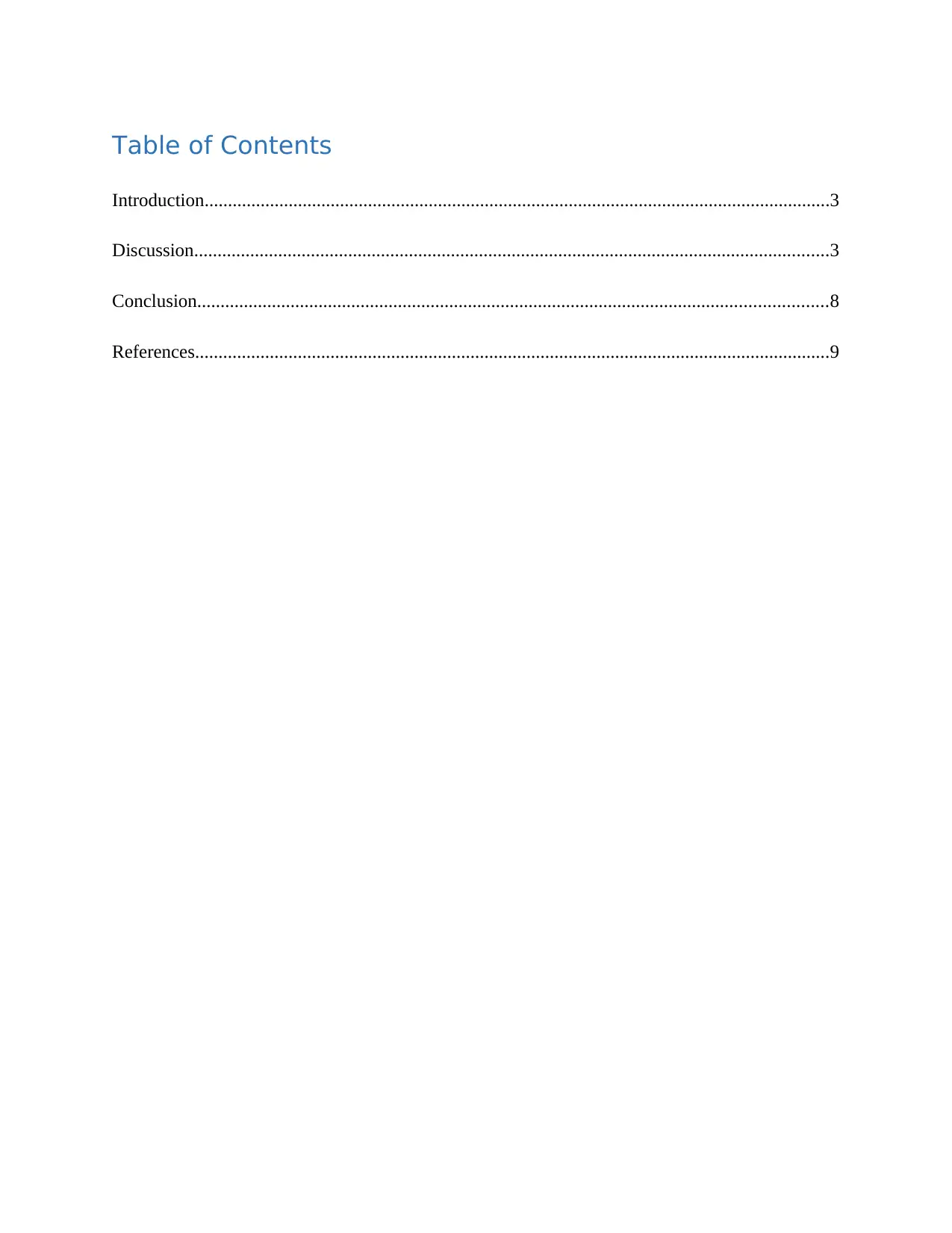
Table of Contents
Introduction......................................................................................................................................3
Discussion........................................................................................................................................3
Conclusion.......................................................................................................................................8
References........................................................................................................................................9
Introduction......................................................................................................................................3
Discussion........................................................................................................................................3
Conclusion.......................................................................................................................................8
References........................................................................................................................................9
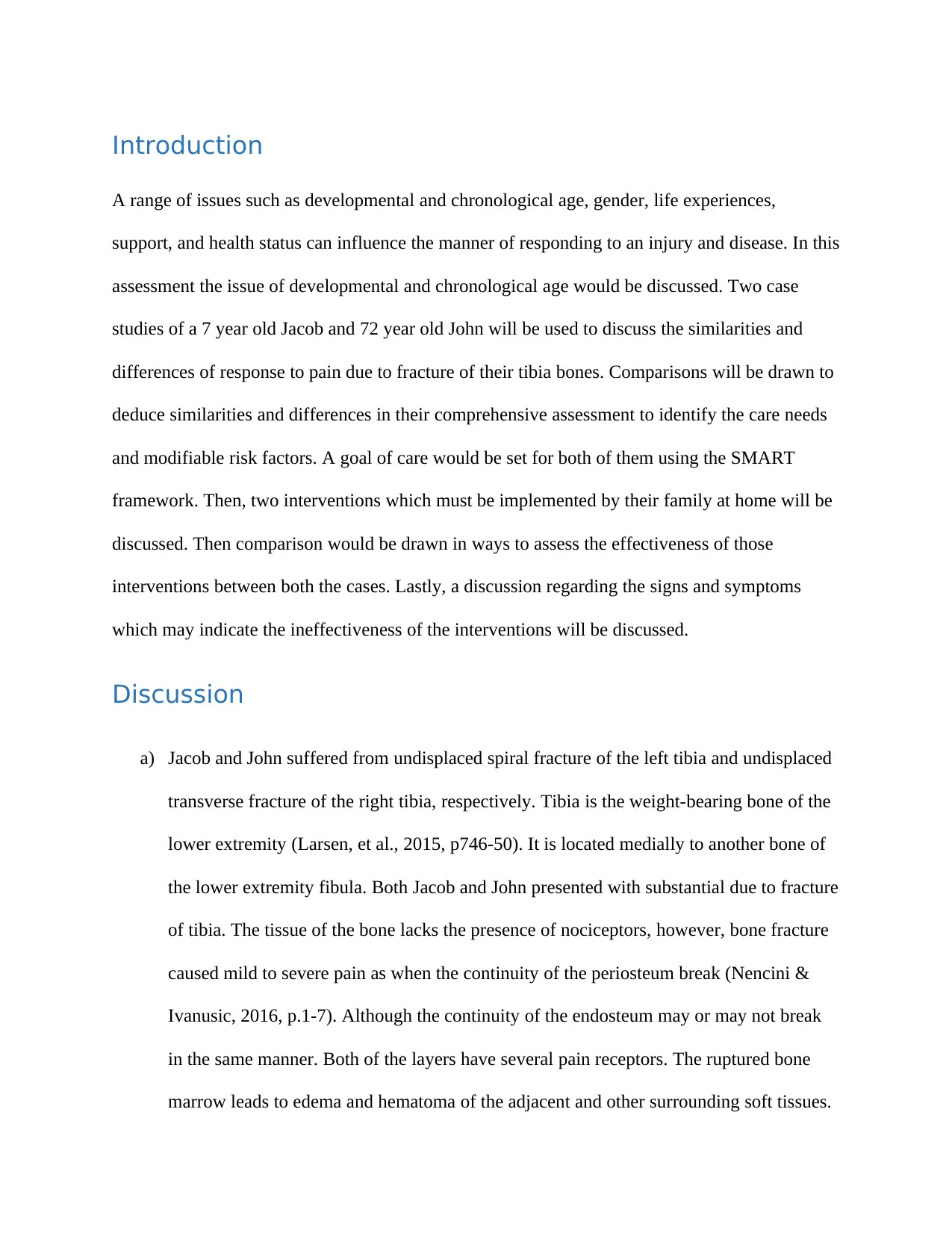
Introduction
A range of issues such as developmental and chronological age, gender, life experiences,
support, and health status can influence the manner of responding to an injury and disease. In this
assessment the issue of developmental and chronological age would be discussed. Two case
studies of a 7 year old Jacob and 72 year old John will be used to discuss the similarities and
differences of response to pain due to fracture of their tibia bones. Comparisons will be drawn to
deduce similarities and differences in their comprehensive assessment to identify the care needs
and modifiable risk factors. A goal of care would be set for both of them using the SMART
framework. Then, two interventions which must be implemented by their family at home will be
discussed. Then comparison would be drawn in ways to assess the effectiveness of those
interventions between both the cases. Lastly, a discussion regarding the signs and symptoms
which may indicate the ineffectiveness of the interventions will be discussed.
Discussion
a) Jacob and John suffered from undisplaced spiral fracture of the left tibia and undisplaced
transverse fracture of the right tibia, respectively. Tibia is the weight-bearing bone of the
lower extremity (Larsen, et al., 2015, p746-50). It is located medially to another bone of
the lower extremity fibula. Both Jacob and John presented with substantial due to fracture
of tibia. The tissue of the bone lacks the presence of nociceptors, however, bone fracture
caused mild to severe pain as when the continuity of the periosteum break (Nencini &
Ivanusic, 2016, p.1-7). Although the continuity of the endosteum may or may not break
in the same manner. Both of the layers have several pain receptors. The ruptured bone
marrow leads to edema and hematoma of the adjacent and other surrounding soft tissues.
A range of issues such as developmental and chronological age, gender, life experiences,
support, and health status can influence the manner of responding to an injury and disease. In this
assessment the issue of developmental and chronological age would be discussed. Two case
studies of a 7 year old Jacob and 72 year old John will be used to discuss the similarities and
differences of response to pain due to fracture of their tibia bones. Comparisons will be drawn to
deduce similarities and differences in their comprehensive assessment to identify the care needs
and modifiable risk factors. A goal of care would be set for both of them using the SMART
framework. Then, two interventions which must be implemented by their family at home will be
discussed. Then comparison would be drawn in ways to assess the effectiveness of those
interventions between both the cases. Lastly, a discussion regarding the signs and symptoms
which may indicate the ineffectiveness of the interventions will be discussed.
Discussion
a) Jacob and John suffered from undisplaced spiral fracture of the left tibia and undisplaced
transverse fracture of the right tibia, respectively. Tibia is the weight-bearing bone of the
lower extremity (Larsen, et al., 2015, p746-50). It is located medially to another bone of
the lower extremity fibula. Both Jacob and John presented with substantial due to fracture
of tibia. The tissue of the bone lacks the presence of nociceptors, however, bone fracture
caused mild to severe pain as when the continuity of the periosteum break (Nencini &
Ivanusic, 2016, p.1-7). Although the continuity of the endosteum may or may not break
in the same manner. Both of the layers have several pain receptors. The ruptured bone
marrow leads to edema and hematoma of the adjacent and other surrounding soft tissues.
⊘ This is a preview!⊘
Do you want full access?
Subscribe today to unlock all pages.

Trusted by 1+ million students worldwide
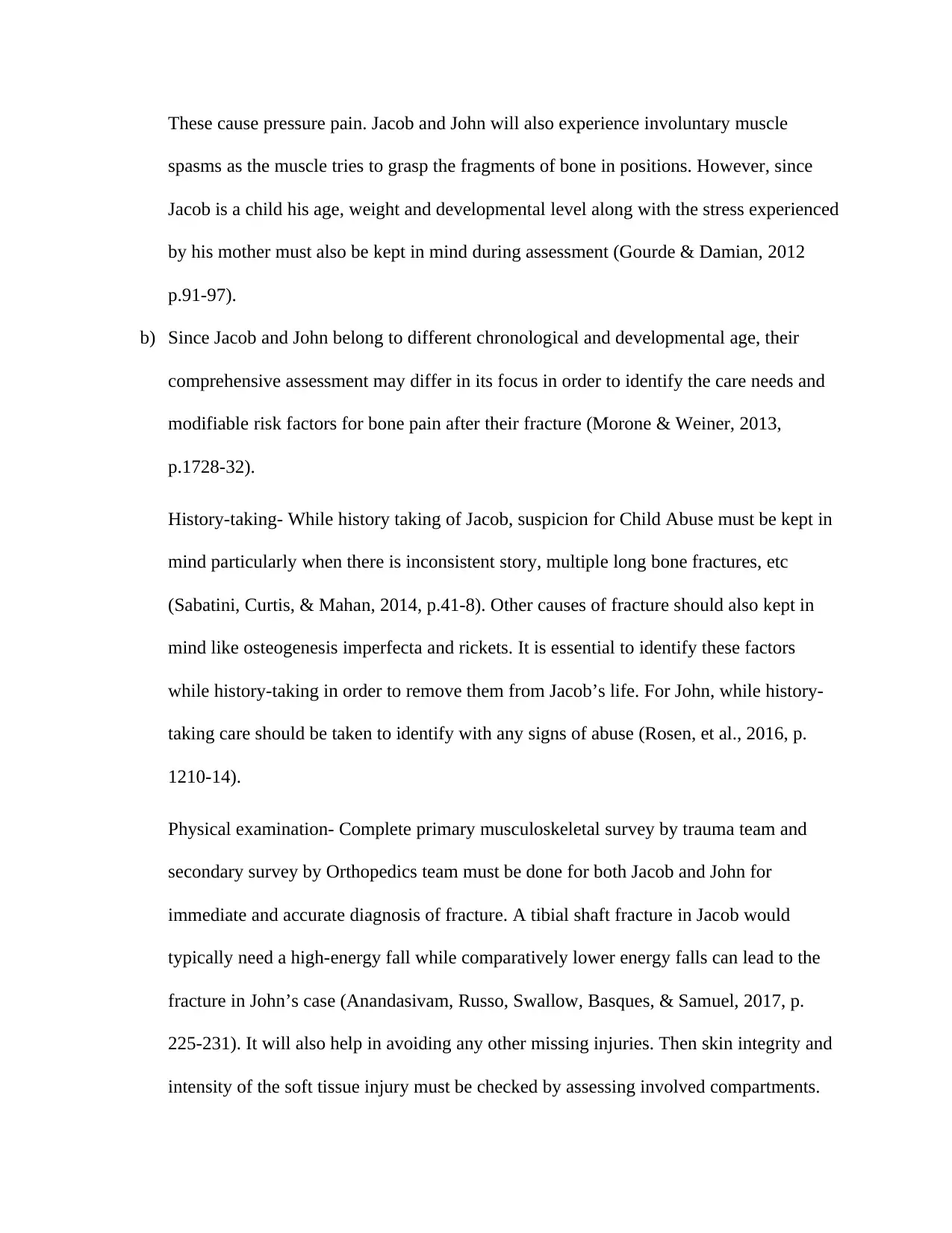
These cause pressure pain. Jacob and John will also experience involuntary muscle
spasms as the muscle tries to grasp the fragments of bone in positions. However, since
Jacob is a child his age, weight and developmental level along with the stress experienced
by his mother must also be kept in mind during assessment (Gourde & Damian, 2012
p.91-97).
b) Since Jacob and John belong to different chronological and developmental age, their
comprehensive assessment may differ in its focus in order to identify the care needs and
modifiable risk factors for bone pain after their fracture (Morone & Weiner, 2013,
p.1728-32).
History-taking- While history taking of Jacob, suspicion for Child Abuse must be kept in
mind particularly when there is inconsistent story, multiple long bone fractures, etc
(Sabatini, Curtis, & Mahan, 2014, p.41-8). Other causes of fracture should also kept in
mind like osteogenesis imperfecta and rickets. It is essential to identify these factors
while history-taking in order to remove them from Jacob’s life. For John, while history-
taking care should be taken to identify with any signs of abuse (Rosen, et al., 2016, p.
1210-14).
Physical examination- Complete primary musculoskeletal survey by trauma team and
secondary survey by Orthopedics team must be done for both Jacob and John for
immediate and accurate diagnosis of fracture. A tibial shaft fracture in Jacob would
typically need a high-energy fall while comparatively lower energy falls can lead to the
fracture in John’s case (Anandasivam, Russo, Swallow, Basques, & Samuel, 2017, p.
225-231). It will also help in avoiding any other missing injuries. Then skin integrity and
intensity of the soft tissue injury must be checked by assessing involved compartments.
spasms as the muscle tries to grasp the fragments of bone in positions. However, since
Jacob is a child his age, weight and developmental level along with the stress experienced
by his mother must also be kept in mind during assessment (Gourde & Damian, 2012
p.91-97).
b) Since Jacob and John belong to different chronological and developmental age, their
comprehensive assessment may differ in its focus in order to identify the care needs and
modifiable risk factors for bone pain after their fracture (Morone & Weiner, 2013,
p.1728-32).
History-taking- While history taking of Jacob, suspicion for Child Abuse must be kept in
mind particularly when there is inconsistent story, multiple long bone fractures, etc
(Sabatini, Curtis, & Mahan, 2014, p.41-8). Other causes of fracture should also kept in
mind like osteogenesis imperfecta and rickets. It is essential to identify these factors
while history-taking in order to remove them from Jacob’s life. For John, while history-
taking care should be taken to identify with any signs of abuse (Rosen, et al., 2016, p.
1210-14).
Physical examination- Complete primary musculoskeletal survey by trauma team and
secondary survey by Orthopedics team must be done for both Jacob and John for
immediate and accurate diagnosis of fracture. A tibial shaft fracture in Jacob would
typically need a high-energy fall while comparatively lower energy falls can lead to the
fracture in John’s case (Anandasivam, Russo, Swallow, Basques, & Samuel, 2017, p.
225-231). It will also help in avoiding any other missing injuries. Then skin integrity and
intensity of the soft tissue injury must be checked by assessing involved compartments.
Paraphrase This Document
Need a fresh take? Get an instant paraphrase of this document with our AI Paraphraser
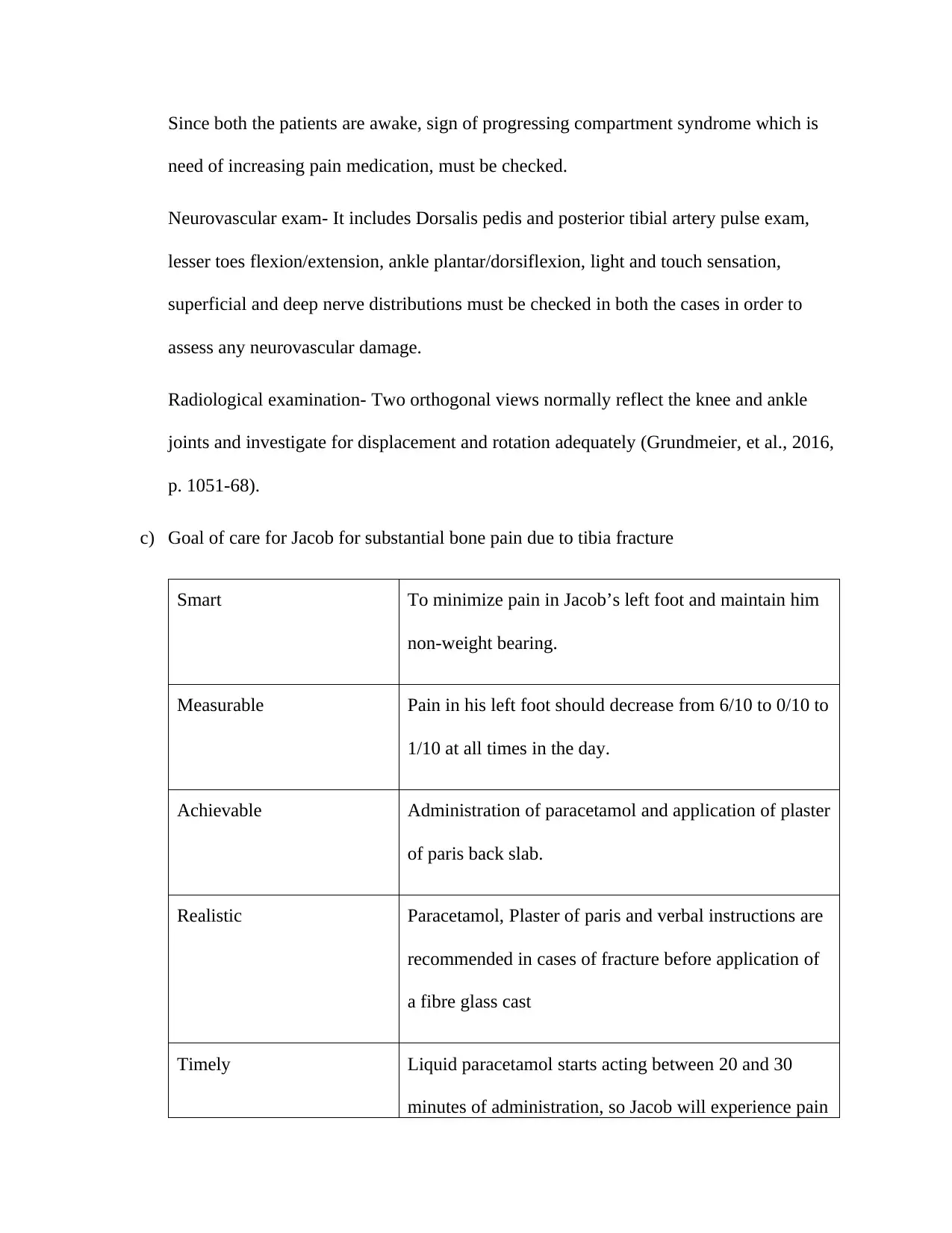
Since both the patients are awake, sign of progressing compartment syndrome which is
need of increasing pain medication, must be checked.
Neurovascular exam- It includes Dorsalis pedis and posterior tibial artery pulse exam,
lesser toes flexion/extension, ankle plantar/dorsiflexion, light and touch sensation,
superficial and deep nerve distributions must be checked in both the cases in order to
assess any neurovascular damage.
Radiological examination- Two orthogonal views normally reflect the knee and ankle
joints and investigate for displacement and rotation adequately (Grundmeier, et al., 2016,
p. 1051-68).
c) Goal of care for Jacob for substantial bone pain due to tibia fracture
Smart To minimize pain in Jacob’s left foot and maintain him
non-weight bearing.
Measurable Pain in his left foot should decrease from 6/10 to 0/10 to
1/10 at all times in the day.
Achievable Administration of paracetamol and application of plaster
of paris back slab.
Realistic Paracetamol, Plaster of paris and verbal instructions are
recommended in cases of fracture before application of
a fibre glass cast
Timely Liquid paracetamol starts acting between 20 and 30
minutes of administration, so Jacob will experience pain
need of increasing pain medication, must be checked.
Neurovascular exam- It includes Dorsalis pedis and posterior tibial artery pulse exam,
lesser toes flexion/extension, ankle plantar/dorsiflexion, light and touch sensation,
superficial and deep nerve distributions must be checked in both the cases in order to
assess any neurovascular damage.
Radiological examination- Two orthogonal views normally reflect the knee and ankle
joints and investigate for displacement and rotation adequately (Grundmeier, et al., 2016,
p. 1051-68).
c) Goal of care for Jacob for substantial bone pain due to tibia fracture
Smart To minimize pain in Jacob’s left foot and maintain him
non-weight bearing.
Measurable Pain in his left foot should decrease from 6/10 to 0/10 to
1/10 at all times in the day.
Achievable Administration of paracetamol and application of plaster
of paris back slab.
Realistic Paracetamol, Plaster of paris and verbal instructions are
recommended in cases of fracture before application of
a fibre glass cast
Timely Liquid paracetamol starts acting between 20 and 30
minutes of administration, so Jacob will experience pain
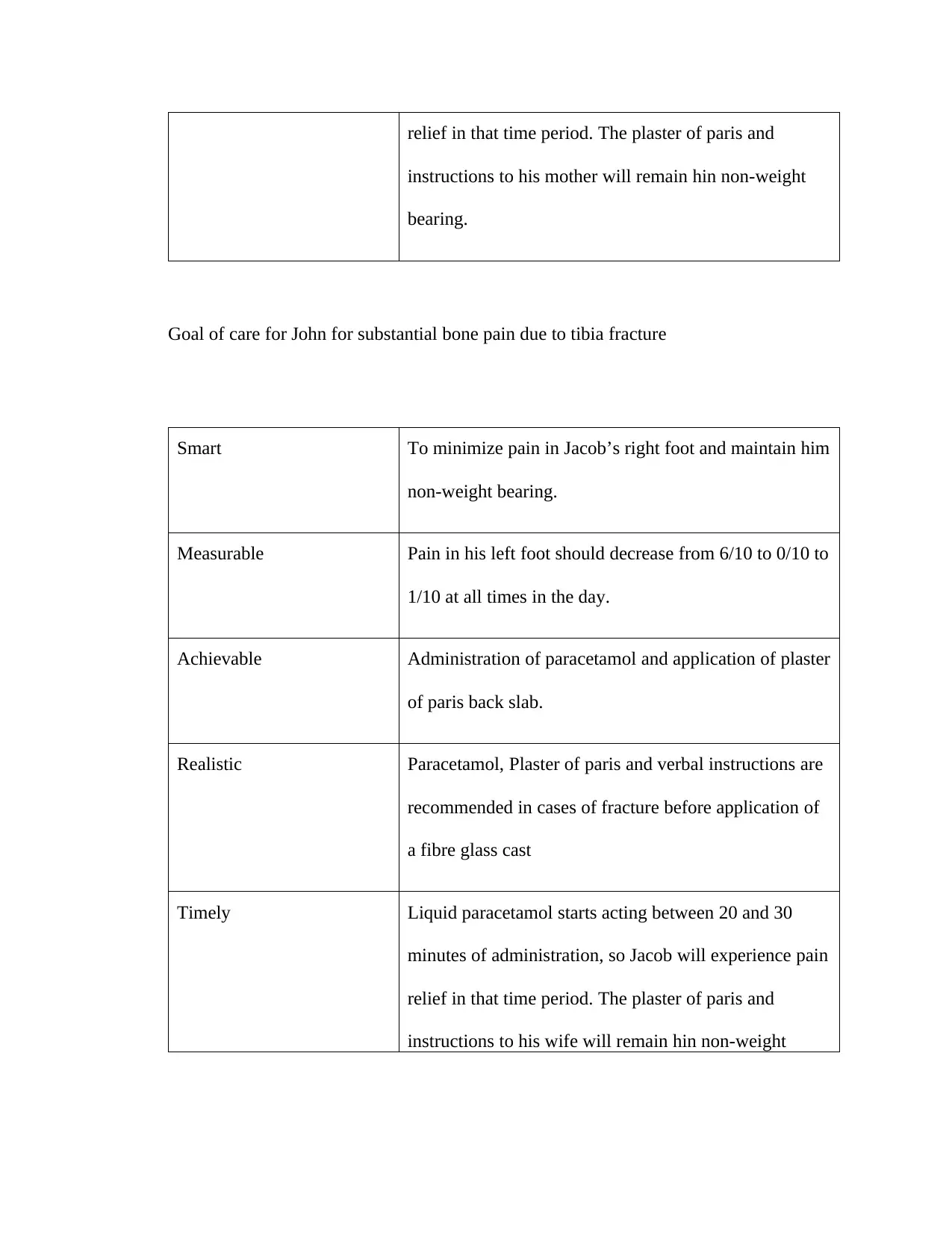
relief in that time period. The plaster of paris and
instructions to his mother will remain hin non-weight
bearing.
Goal of care for John for substantial bone pain due to tibia fracture
Smart To minimize pain in Jacob’s right foot and maintain him
non-weight bearing.
Measurable Pain in his left foot should decrease from 6/10 to 0/10 to
1/10 at all times in the day.
Achievable Administration of paracetamol and application of plaster
of paris back slab.
Realistic Paracetamol, Plaster of paris and verbal instructions are
recommended in cases of fracture before application of
a fibre glass cast
Timely Liquid paracetamol starts acting between 20 and 30
minutes of administration, so Jacob will experience pain
relief in that time period. The plaster of paris and
instructions to his wife will remain hin non-weight
instructions to his mother will remain hin non-weight
bearing.
Goal of care for John for substantial bone pain due to tibia fracture
Smart To minimize pain in Jacob’s right foot and maintain him
non-weight bearing.
Measurable Pain in his left foot should decrease from 6/10 to 0/10 to
1/10 at all times in the day.
Achievable Administration of paracetamol and application of plaster
of paris back slab.
Realistic Paracetamol, Plaster of paris and verbal instructions are
recommended in cases of fracture before application of
a fibre glass cast
Timely Liquid paracetamol starts acting between 20 and 30
minutes of administration, so Jacob will experience pain
relief in that time period. The plaster of paris and
instructions to his wife will remain hin non-weight
⊘ This is a preview!⊘
Do you want full access?
Subscribe today to unlock all pages.

Trusted by 1+ million students worldwide
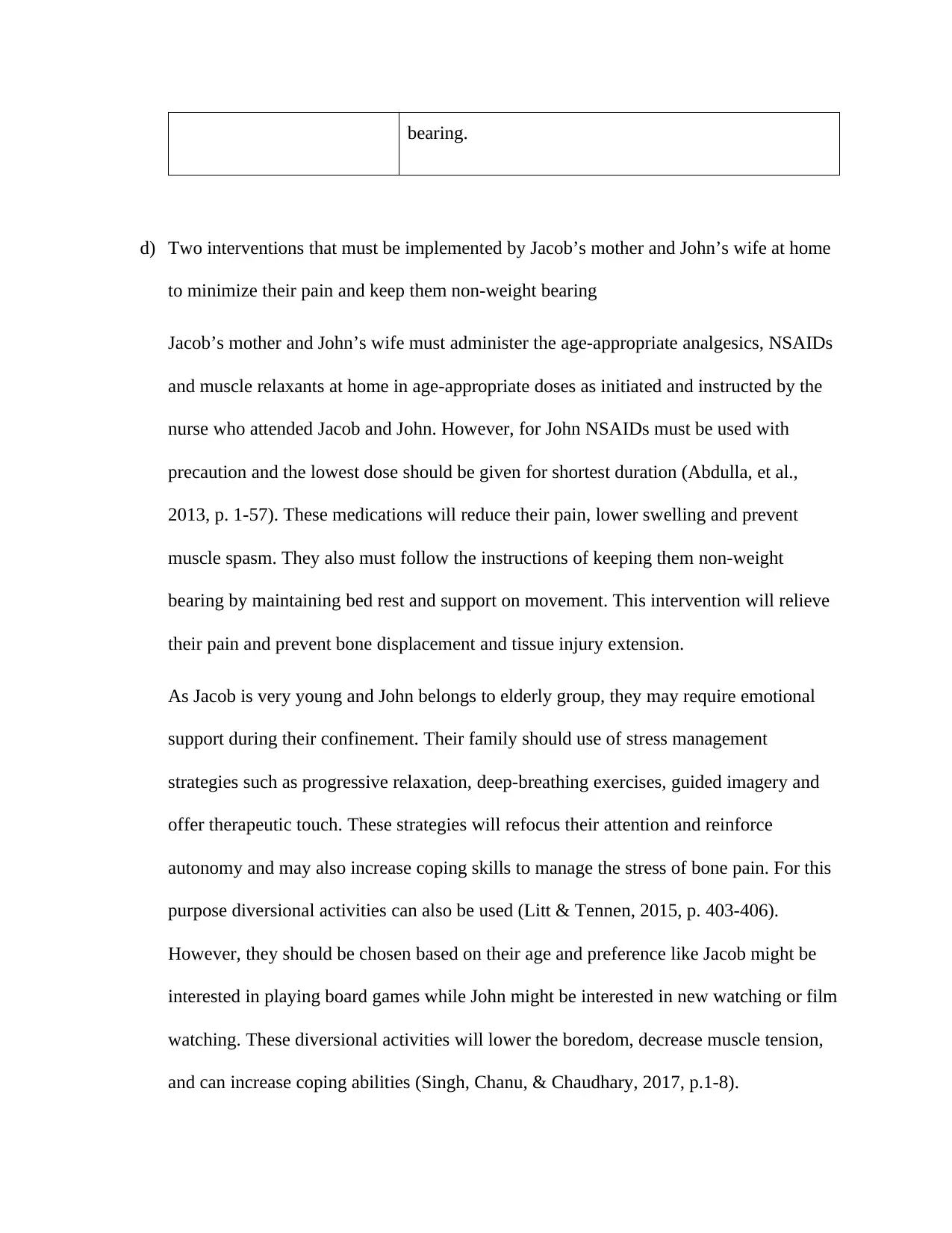
bearing.
d) Two interventions that must be implemented by Jacob’s mother and John’s wife at home
to minimize their pain and keep them non-weight bearing
Jacob’s mother and John’s wife must administer the age-appropriate analgesics, NSAIDs
and muscle relaxants at home in age-appropriate doses as initiated and instructed by the
nurse who attended Jacob and John. However, for John NSAIDs must be used with
precaution and the lowest dose should be given for shortest duration (Abdulla, et al.,
2013, p. 1-57). These medications will reduce their pain, lower swelling and prevent
muscle spasm. They also must follow the instructions of keeping them non-weight
bearing by maintaining bed rest and support on movement. This intervention will relieve
their pain and prevent bone displacement and tissue injury extension.
As Jacob is very young and John belongs to elderly group, they may require emotional
support during their confinement. Their family should use of stress management
strategies such as progressive relaxation, deep-breathing exercises, guided imagery and
offer therapeutic touch. These strategies will refocus their attention and reinforce
autonomy and may also increase coping skills to manage the stress of bone pain. For this
purpose diversional activities can also be used (Litt & Tennen, 2015, p. 403-406).
However, they should be chosen based on their age and preference like Jacob might be
interested in playing board games while John might be interested in new watching or film
watching. These diversional activities will lower the boredom, decrease muscle tension,
and can increase coping abilities (Singh, Chanu, & Chaudhary, 2017, p.1-8).
d) Two interventions that must be implemented by Jacob’s mother and John’s wife at home
to minimize their pain and keep them non-weight bearing
Jacob’s mother and John’s wife must administer the age-appropriate analgesics, NSAIDs
and muscle relaxants at home in age-appropriate doses as initiated and instructed by the
nurse who attended Jacob and John. However, for John NSAIDs must be used with
precaution and the lowest dose should be given for shortest duration (Abdulla, et al.,
2013, p. 1-57). These medications will reduce their pain, lower swelling and prevent
muscle spasm. They also must follow the instructions of keeping them non-weight
bearing by maintaining bed rest and support on movement. This intervention will relieve
their pain and prevent bone displacement and tissue injury extension.
As Jacob is very young and John belongs to elderly group, they may require emotional
support during their confinement. Their family should use of stress management
strategies such as progressive relaxation, deep-breathing exercises, guided imagery and
offer therapeutic touch. These strategies will refocus their attention and reinforce
autonomy and may also increase coping skills to manage the stress of bone pain. For this
purpose diversional activities can also be used (Litt & Tennen, 2015, p. 403-406).
However, they should be chosen based on their age and preference like Jacob might be
interested in playing board games while John might be interested in new watching or film
watching. These diversional activities will lower the boredom, decrease muscle tension,
and can increase coping abilities (Singh, Chanu, & Chaudhary, 2017, p.1-8).
Paraphrase This Document
Need a fresh take? Get an instant paraphrase of this document with our AI Paraphraser
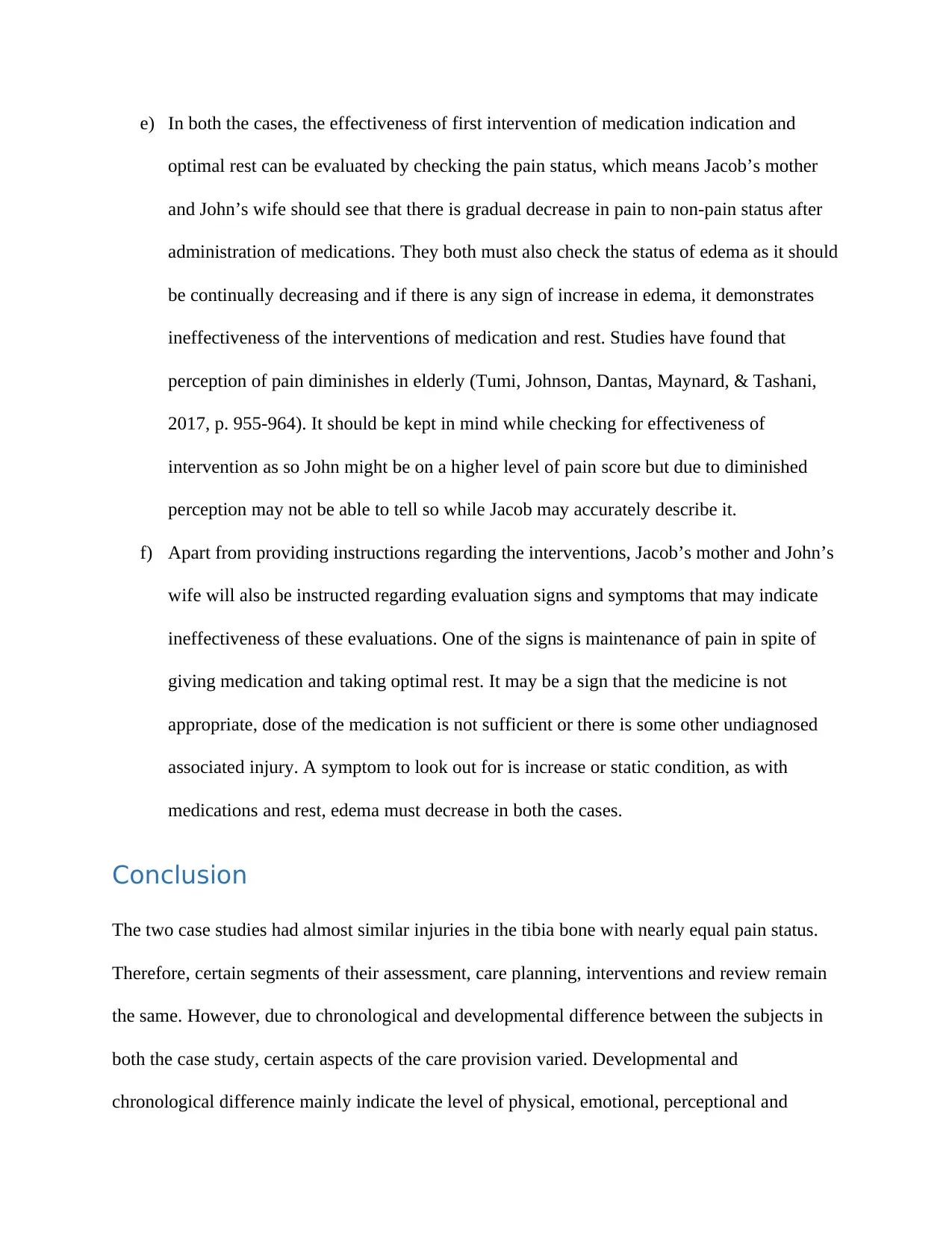
e) In both the cases, the effectiveness of first intervention of medication indication and
optimal rest can be evaluated by checking the pain status, which means Jacob’s mother
and John’s wife should see that there is gradual decrease in pain to non-pain status after
administration of medications. They both must also check the status of edema as it should
be continually decreasing and if there is any sign of increase in edema, it demonstrates
ineffectiveness of the interventions of medication and rest. Studies have found that
perception of pain diminishes in elderly (Tumi, Johnson, Dantas, Maynard, & Tashani,
2017, p. 955-964). It should be kept in mind while checking for effectiveness of
intervention as so John might be on a higher level of pain score but due to diminished
perception may not be able to tell so while Jacob may accurately describe it.
f) Apart from providing instructions regarding the interventions, Jacob’s mother and John’s
wife will also be instructed regarding evaluation signs and symptoms that may indicate
ineffectiveness of these evaluations. One of the signs is maintenance of pain in spite of
giving medication and taking optimal rest. It may be a sign that the medicine is not
appropriate, dose of the medication is not sufficient or there is some other undiagnosed
associated injury. A symptom to look out for is increase or static condition, as with
medications and rest, edema must decrease in both the cases.
Conclusion
The two case studies had almost similar injuries in the tibia bone with nearly equal pain status.
Therefore, certain segments of their assessment, care planning, interventions and review remain
the same. However, due to chronological and developmental difference between the subjects in
both the case study, certain aspects of the care provision varied. Developmental and
chronological difference mainly indicate the level of physical, emotional, perceptional and
optimal rest can be evaluated by checking the pain status, which means Jacob’s mother
and John’s wife should see that there is gradual decrease in pain to non-pain status after
administration of medications. They both must also check the status of edema as it should
be continually decreasing and if there is any sign of increase in edema, it demonstrates
ineffectiveness of the interventions of medication and rest. Studies have found that
perception of pain diminishes in elderly (Tumi, Johnson, Dantas, Maynard, & Tashani,
2017, p. 955-964). It should be kept in mind while checking for effectiveness of
intervention as so John might be on a higher level of pain score but due to diminished
perception may not be able to tell so while Jacob may accurately describe it.
f) Apart from providing instructions regarding the interventions, Jacob’s mother and John’s
wife will also be instructed regarding evaluation signs and symptoms that may indicate
ineffectiveness of these evaluations. One of the signs is maintenance of pain in spite of
giving medication and taking optimal rest. It may be a sign that the medicine is not
appropriate, dose of the medication is not sufficient or there is some other undiagnosed
associated injury. A symptom to look out for is increase or static condition, as with
medications and rest, edema must decrease in both the cases.
Conclusion
The two case studies had almost similar injuries in the tibia bone with nearly equal pain status.
Therefore, certain segments of their assessment, care planning, interventions and review remain
the same. However, due to chronological and developmental difference between the subjects in
both the case study, certain aspects of the care provision varied. Developmental and
chronological difference mainly indicate the level of physical, emotional, perceptional and
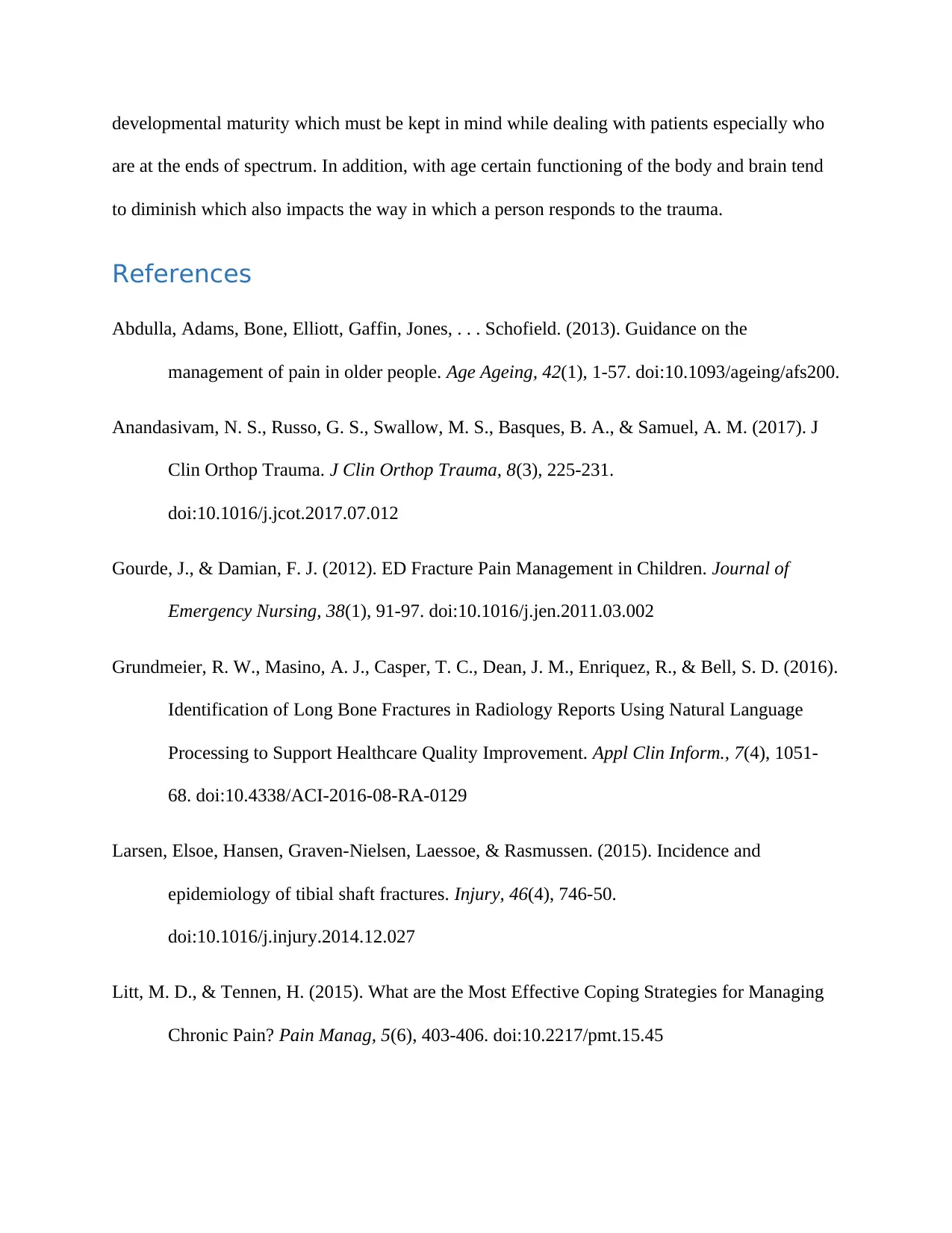
developmental maturity which must be kept in mind while dealing with patients especially who
are at the ends of spectrum. In addition, with age certain functioning of the body and brain tend
to diminish which also impacts the way in which a person responds to the trauma.
References
Abdulla, Adams, Bone, Elliott, Gaffin, Jones, . . . Schofield. (2013). Guidance on the
management of pain in older people. Age Ageing, 42(1), 1-57. doi:10.1093/ageing/afs200.
Anandasivam, N. S., Russo, G. S., Swallow, M. S., Basques, B. A., & Samuel, A. M. (2017). J
Clin Orthop Trauma. J Clin Orthop Trauma, 8(3), 225-231.
doi:10.1016/j.jcot.2017.07.012
Gourde, J., & Damian, F. J. (2012). ED Fracture Pain Management in Children. Journal of
Emergency Nursing, 38(1), 91-97. doi:10.1016/j.jen.2011.03.002
Grundmeier, R. W., Masino, A. J., Casper, T. C., Dean, J. M., Enriquez, R., & Bell, S. D. (2016).
Identification of Long Bone Fractures in Radiology Reports Using Natural Language
Processing to Support Healthcare Quality Improvement. Appl Clin Inform., 7(4), 1051-
68. doi:10.4338/ACI-2016-08-RA-0129
Larsen, Elsoe, Hansen, Graven-Nielsen, Laessoe, & Rasmussen. (2015). Incidence and
epidemiology of tibial shaft fractures. Injury, 46(4), 746-50.
doi:10.1016/j.injury.2014.12.027
Litt, M. D., & Tennen, H. (2015). What are the Most Effective Coping Strategies for Managing
Chronic Pain? Pain Manag, 5(6), 403-406. doi:10.2217/pmt.15.45
are at the ends of spectrum. In addition, with age certain functioning of the body and brain tend
to diminish which also impacts the way in which a person responds to the trauma.
References
Abdulla, Adams, Bone, Elliott, Gaffin, Jones, . . . Schofield. (2013). Guidance on the
management of pain in older people. Age Ageing, 42(1), 1-57. doi:10.1093/ageing/afs200.
Anandasivam, N. S., Russo, G. S., Swallow, M. S., Basques, B. A., & Samuel, A. M. (2017). J
Clin Orthop Trauma. J Clin Orthop Trauma, 8(3), 225-231.
doi:10.1016/j.jcot.2017.07.012
Gourde, J., & Damian, F. J. (2012). ED Fracture Pain Management in Children. Journal of
Emergency Nursing, 38(1), 91-97. doi:10.1016/j.jen.2011.03.002
Grundmeier, R. W., Masino, A. J., Casper, T. C., Dean, J. M., Enriquez, R., & Bell, S. D. (2016).
Identification of Long Bone Fractures in Radiology Reports Using Natural Language
Processing to Support Healthcare Quality Improvement. Appl Clin Inform., 7(4), 1051-
68. doi:10.4338/ACI-2016-08-RA-0129
Larsen, Elsoe, Hansen, Graven-Nielsen, Laessoe, & Rasmussen. (2015). Incidence and
epidemiology of tibial shaft fractures. Injury, 46(4), 746-50.
doi:10.1016/j.injury.2014.12.027
Litt, M. D., & Tennen, H. (2015). What are the Most Effective Coping Strategies for Managing
Chronic Pain? Pain Manag, 5(6), 403-406. doi:10.2217/pmt.15.45
⊘ This is a preview!⊘
Do you want full access?
Subscribe today to unlock all pages.

Trusted by 1+ million students worldwide
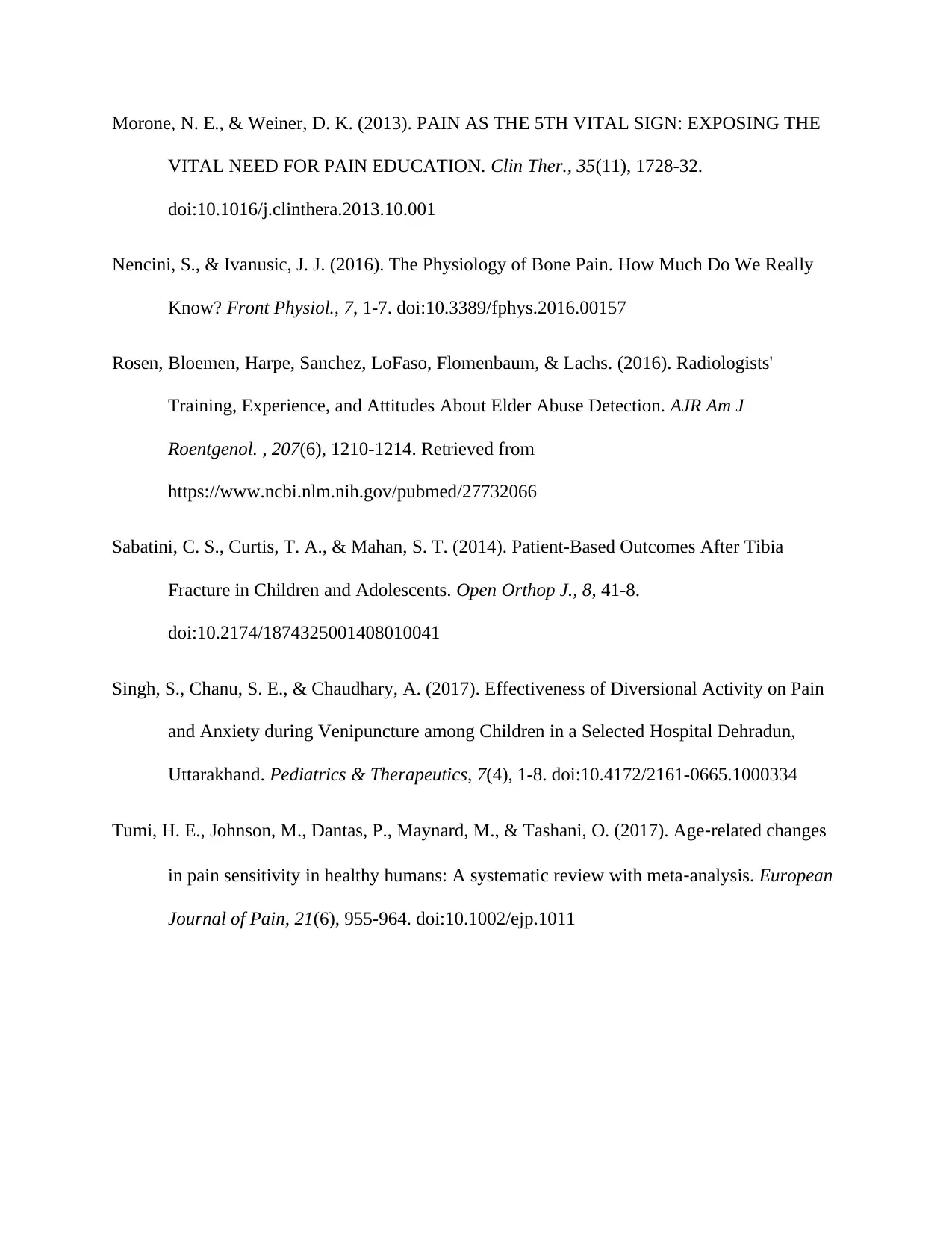
Morone, N. E., & Weiner, D. K. (2013). PAIN AS THE 5TH VITAL SIGN: EXPOSING THE
VITAL NEED FOR PAIN EDUCATION. Clin Ther., 35(11), 1728-32.
doi:10.1016/j.clinthera.2013.10.001
Nencini, S., & Ivanusic, J. J. (2016). The Physiology of Bone Pain. How Much Do We Really
Know? Front Physiol., 7, 1-7. doi:10.3389/fphys.2016.00157
Rosen, Bloemen, Harpe, Sanchez, LoFaso, Flomenbaum, & Lachs. (2016). Radiologists'
Training, Experience, and Attitudes About Elder Abuse Detection. AJR Am J
Roentgenol. , 207(6), 1210-1214. Retrieved from
https://www.ncbi.nlm.nih.gov/pubmed/27732066
Sabatini, C. S., Curtis, T. A., & Mahan, S. T. (2014). Patient-Based Outcomes After Tibia
Fracture in Children and Adolescents. Open Orthop J., 8, 41-8.
doi:10.2174/1874325001408010041
Singh, S., Chanu, S. E., & Chaudhary, A. (2017). Effectiveness of Diversional Activity on Pain
and Anxiety during Venipuncture among Children in a Selected Hospital Dehradun,
Uttarakhand. Pediatrics & Therapeutics, 7(4), 1-8. doi:10.4172/2161-0665.1000334
Tumi, H. E., Johnson, M., Dantas, P., Maynard, M., & Tashani, O. (2017). Age‐related changes
in pain sensitivity in healthy humans: A systematic review with meta‐analysis. European
Journal of Pain, 21(6), 955-964. doi:10.1002/ejp.1011
VITAL NEED FOR PAIN EDUCATION. Clin Ther., 35(11), 1728-32.
doi:10.1016/j.clinthera.2013.10.001
Nencini, S., & Ivanusic, J. J. (2016). The Physiology of Bone Pain. How Much Do We Really
Know? Front Physiol., 7, 1-7. doi:10.3389/fphys.2016.00157
Rosen, Bloemen, Harpe, Sanchez, LoFaso, Flomenbaum, & Lachs. (2016). Radiologists'
Training, Experience, and Attitudes About Elder Abuse Detection. AJR Am J
Roentgenol. , 207(6), 1210-1214. Retrieved from
https://www.ncbi.nlm.nih.gov/pubmed/27732066
Sabatini, C. S., Curtis, T. A., & Mahan, S. T. (2014). Patient-Based Outcomes After Tibia
Fracture in Children and Adolescents. Open Orthop J., 8, 41-8.
doi:10.2174/1874325001408010041
Singh, S., Chanu, S. E., & Chaudhary, A. (2017). Effectiveness of Diversional Activity on Pain
and Anxiety during Venipuncture among Children in a Selected Hospital Dehradun,
Uttarakhand. Pediatrics & Therapeutics, 7(4), 1-8. doi:10.4172/2161-0665.1000334
Tumi, H. E., Johnson, M., Dantas, P., Maynard, M., & Tashani, O. (2017). Age‐related changes
in pain sensitivity in healthy humans: A systematic review with meta‐analysis. European
Journal of Pain, 21(6), 955-964. doi:10.1002/ejp.1011
1 out of 10
Related Documents
Your All-in-One AI-Powered Toolkit for Academic Success.
+13062052269
info@desklib.com
Available 24*7 on WhatsApp / Email
![[object Object]](/_next/static/media/star-bottom.7253800d.svg)
Unlock your academic potential
Copyright © 2020–2025 A2Z Services. All Rights Reserved. Developed and managed by ZUCOL.



